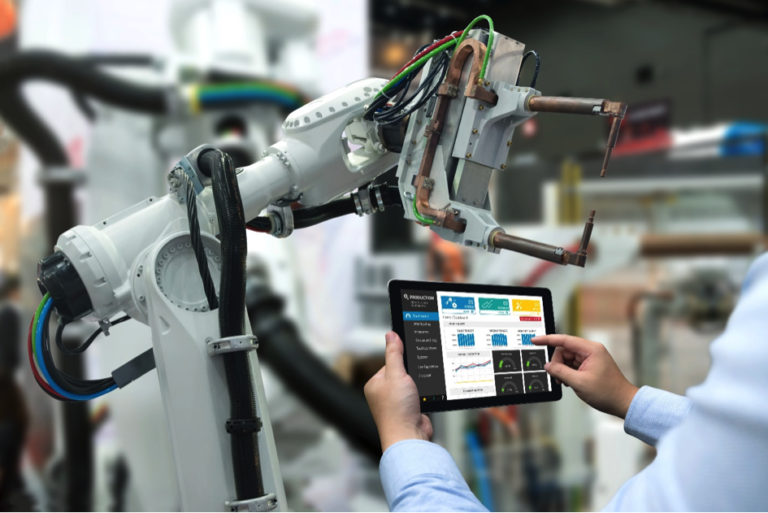Guest post by Hervé Lesage, Global Marketing Manager, Communication & Marketing Services
Shrinking electronic devices and improvements in connectivity continue to change how we access product information. Sometimes we use a desktop screen to read, but often we prefer content on a smartphone or tablet closer to point of need. This is trending in fascinating ways as the innovations of augmented reality (AR), virtual reality (VR) and mixed reality (MR) bring new possibilities.
Manufacturers are taking advantage of AR throughout the product lifecycle, where they face pressure to launch products more quickly while in the grip of a growing gap in engineering expertise. As smart wearables get more affordable, use of AR is growing rapidly as a tool to bolster employee information and performance. Volkswagen AG Virtual Engineering Lab (VEL) uses VR head-mounted displays (HMDs) and HoloLens smartglasses to replace or augment physical mock-ups of car prototypes with virtual views. The technology also allows teams in different locations to collaborate.
Manufacturers use AR on assembly lines to guide workers and reduce errors. Boeing cut production time by 25% and reduced assembly errors by equipping technicians with AR glasses to wire hundreds of planes a year more efficiently.
Beyond better information navigation, digital delivery brings information to life, especially work life. Communicators can present animations over real-world images on smartphones to guide users through operating or fixing a product.
How AR Product Information Delivery Benefits Sales and Customer Experience
The benefits of AR extend beyond product development and service into sales. Porsche offered vehicle customization for customers to build their dream cars. Who can resist creating the perfect vehicle! Armed with tablet during customer conversations, sales people have a better chance when they carry a full range of options and information at their fingertips.
And once you’ve made a sale, experiences during the customer journey matter. Customers love products that are easy to set up and use, which brings us back to the use of AR and smart devices to access data. Why spend time hunting for the user manual when you can look it up on your phone? Peugeot innovated delivery of ordinary glove box content, giving customers another reason to love their cars.
Is My Product Information Ready for Digital Delivery?
How do you make sure content is ready for digital AR delivery? In the recent past when content was managed mainly as documents, having online PDFs was considered digital delivery. That’s not enough now. Viewing PDFs on a laptop might be OK, but trying to find PDF content on a mobile device is a very different, if not frustrating, experience. Online PDF manuals sometimes lack indexes, making navigation tricky. With smaller screens, users must choose between tiny text or constant scrolling with only part of the page viewable at a time.
Some organizations struggle to take advantage of helpful digital technologies because they’re stuck managing product information as documents. Imagine the mechanics of sending a chunk of information that describes how to do a single specific servicing task. When information lives in a shared network file system or document management system, it’s next to impossible to deliver mobile screen-sized content in context. Yet this would be required for an online knowledge base and a true AR experience. Optimized content management provides a solution.
How Product Information Management and Document Management Differ
Optimized content management for product information fundamentally differs from document management. Rather than managing content in chapters or documents, content management stores it in smaller, modular “chunks” or “topics” linked within the component content management system (cCMS.)
Linking content in the cCMS or reuse by reference is the most efficient way to share and maintain content. When information changes, it allows easy editing across multiple documents at the same time. Once the referenced topic updates in the cCMS, it changes in every document, knowledgebase, and even website that links to or reuses that content chunk. At publication, an authoring tool assembles these chunks into a document for delivery to the customer.
How to Build Information Architecture to Maximize Re-use
But it’s not just about technology. To really optimize product information management, you need information architecture that maximizes re-use. You want consistent, standardized processes throughout product lifecycles. For instance, how CAD data is created during product design impacts its usability for AR delivery later. Manufacturers will need 3D models with the level of detail required for an AR experience in sales and marketing materials.
The ROI when you change how you manage and deliver product information is compelling. Companies see bottom-line benefits through cost savings and revenue growth:
- More loyal customers endorse your product because it’s easy to use and maintain.
- Whether your customer or an engineer is working on a product, end users have a personalized experience with the information they need.
- Customers can solve more problems themselves with easy-to-follow, step-by-step instructions.
- Fix-first-time rates improve when engineers get to the right information quickly and easily.
- It reduces costs of producing technical information for greater content re-use and for workflow automation for authoring, reviewing, translating and publishing.
Let’s talk. With our expertise in Product Information Management, we can make sure you’re ready to take advantage of AR and digital technologies.




[…] creatively about new growth opportunities at the intersection of the physical and digital, such as augmented reality applications, digital printing on objects, and even the combination of the […]